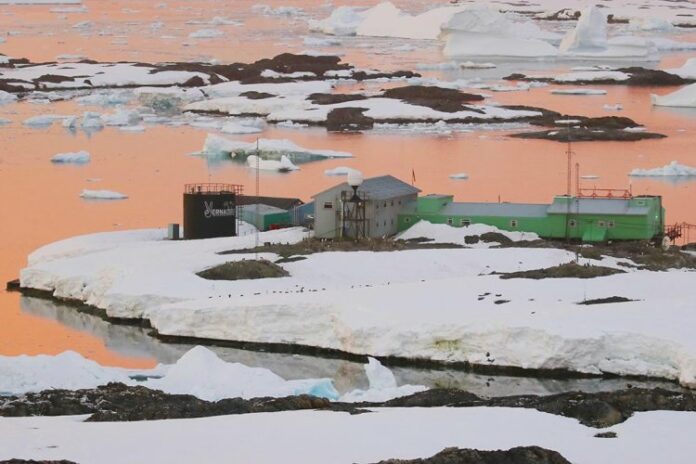For almost 74 years in a row, one of Antarctica’s polar stations has been conducting continuous environmental research. The chain of climate observations has not been interrupted here since 1947. This is a remarkable scientific study that no other station can boast of. At the same time, scientists have to work in difficult conditions due to the very inconvenient location of the research base. The peculiarities of the station`s geographical position led to the process of transferring it from one country in favour of the other.
Base’s features: it is interesting to visit, but it is difficult to work here
Today this station is called the Akademik Vernadsky station and the Ukrainian flag flies over it. It is located on Galindez Island, near the west coast of the Antarctic Peninsula. The research base has several special features that distinguish it from many other stations in Antarctica.
Cruise liners, whose routes pass through Antarctica, often call at the Vernadsky station, as it is the last station on the way to the Antarctic Circle. Besides, tourists are very attracted by the historical atmosphere that prevails here on this base. For example, the station has preserved buildings from ancient times, when people first came here and lived here under one roof with their sled dogs. The best Antarctica’s bar is also located here. It has not only old-fashioned interior but also an original type of alcohol, which is produced directly at the station.
Of course, tourist entertainment is a secondary issue, because the most important thing is scientific research. Unlike many Antarctic stations, the Vernadsky station works not only in summer, but all year round. It means that even when the summer season ends, conditions gradually deteriorate and winter comes, scientists do not interrupt their work and continue to collect and record all the necessary information about the environment.
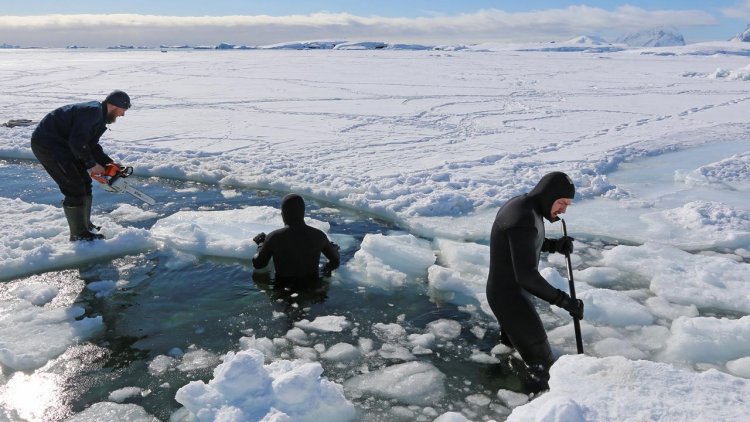
Photo: Creating a channel near the station. Through this channel, researchers on a boat can get to the open water.
There is another feature in the Vernadsky station but it is less pleasant than the previous ones. We are talking about the location of the base. The fact is that this station can be reached only one way – by sea. The runway here is impossible to build due to the complex local terrain (i.e. sharp volcanic rocks, not enough flat space here). Also, there are a lot of problems with the sea route, because the station is not available for ships all year round, but only in summer. That is three or four months, no more. Then the sea is covered with ice and the station can be reached only on powerful icebreakers.
These difficulties with logistics have led to the change of owners of the station.
How the British were looking for their best heirs
This Antarctic station was built by the United Kingdom in 1947 and was named Faraday. That same year, the collection of climate data has started here, which is being carried out to this day, but with only one difference – the Ukrainians are doing this work. How did this happen?
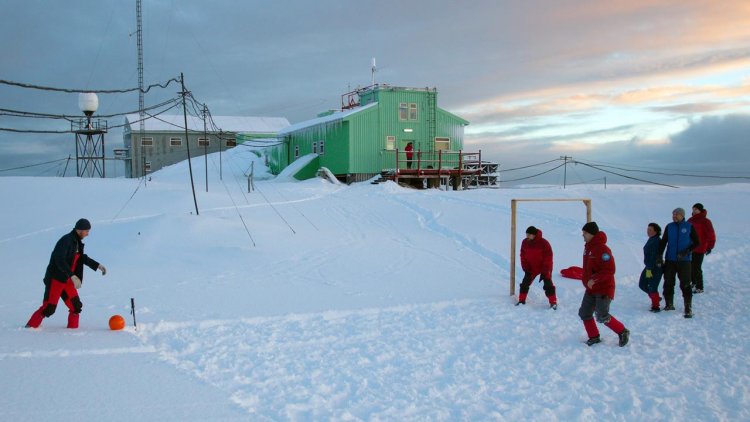
Photo: Preparing for the football championship, the final of which usually takes place at Midwinter. This holiday is celebrated at all Antarctic stations.
The decision to transfer their polar station to another country the British made quite consciously. They started looking for a new owner in the mid-1990s. The United Kingdom had already built a new Rother science base 300 km south of Faraday. This station has a very convenient geographical location, good equipment, as well as a runway and a good berth for icebreakers. Not surprisingly, the UK eventually decided to move all of its scientists here.
Also, it was absolutely obvious that the research and observations at the Faraday station must be continued in order not to interrupt this long chain of data. So, who will do the job if British scientists have changed their location? The British Government has decided to hand over the station to “safe hands”. The search began for a country that does not have its station in Antarctica but has experienced scientists. As a result, Ukraine won this kind of tender.
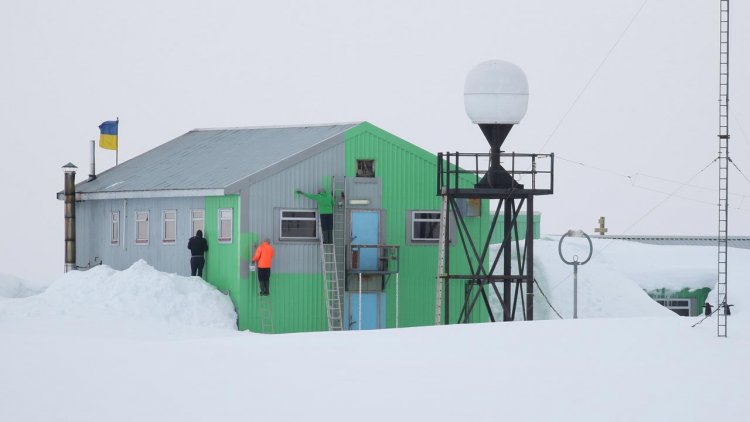
Photo: Participants of the 24th Ukrainian Antarctic Expedition (UAE) paint the facade of the station.
Dr. Evgen Dykyi, Director of the National Antarctic Scientific Center of Ukraine (NASC), explains:
“We had several serious competitors, and, first of all, South Korea, that was ready to invest a lot of money in the project. Ukraine has won here on two important parameters. The first is the presence of its ice class fleet. In the 1990s, there were a large number of research vessels in Ukraine, some of them were of appropriate ice class.
The second advantage was our scientists, who at that time already had a great experience in Antarctica. In fact, the British could just give us the keys to the station and say: work! And we would cope with this situation. The transfer of the station really happened quite quickly – in one incomplete summer season.”
Ukraine had to regain its rights in Antarctica
Here the question immediately arises: where have the Ukrainians gained their significant experience, if their country hadn’t had its station? The fact is that the Ukrainians worked in Antarctica for many years as part of Soviet expeditions. The USSR had as many as 12 research bases there, and many Ukrainians have always worked at each of them. They were there at the time of the collapse of the Union.
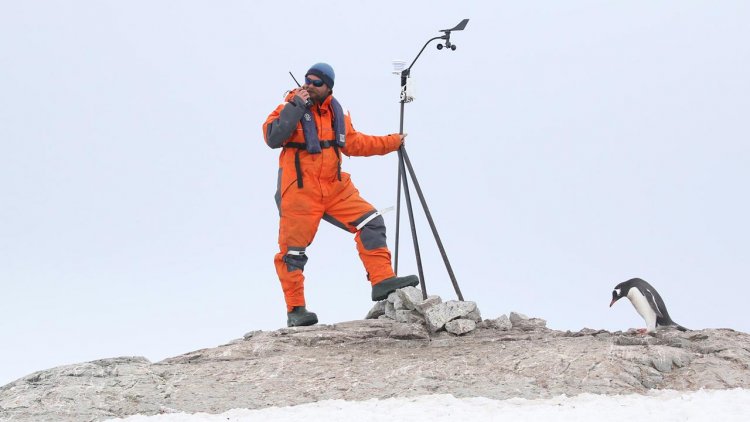
Photo: Meteorologist Alexander Zulas checks the operation of the weather station on Peterman Island.
Evgen Dykyi says:
“Then, in 1991, a miracle happened before our eyes: all 12 stations of SAE (The Soviet Antarctic Expedition, SovAE) in just one night suddenly became RAE (The Russian Antarctic Expedition). It means, Russia claimed the rights to all the USSR’s stations at once. Of course, Ukraine submitted an official diplomatic note demanding the division of bases. Moreover, we asked modestly – to leave us only one or two stations. But Russia refused to make a fair distribution. When Ukraine entered the Antarctic Treaty, already having the Faraday-Vernadsky station in its assets, Russia first blocked our accession. The Russians then insisted on Ukraine having claims to their property. We had to give an official note that we do not claim Russian stations.”
And step by step, all issues related to Faraday’s transfer from the UK to Ukraine were resolved. On February 6, 1996, the Union Jack was lowered at this Antarctic station and the Ukrainian flag was raised for the first time. So, in 2021 the station celebrates an important anniversary – 25 years since the day when the owner country changed. Then the station received a new name. It was named after the famous Ukrainian scientist, mineralogist Vladimir Vernadsky.
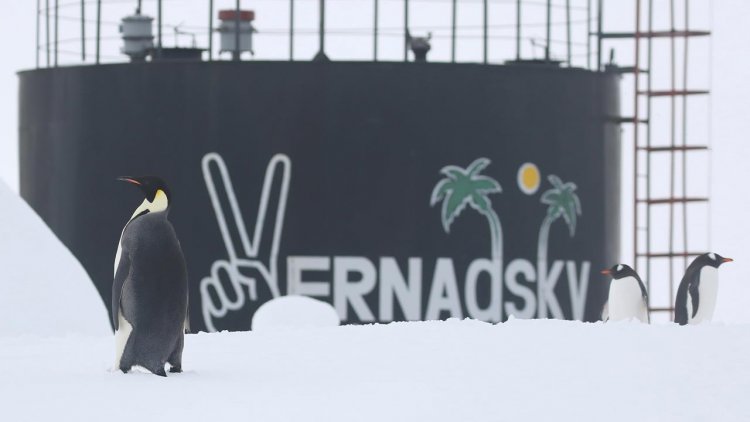
Photo: Occasionally the station is visited by emperor penguins (in the foreground), whose colonies are hundreds of kilometres away. The penguins that breed near the station are subantarctic penguins, or gentoo penguins (in the background). They have a large colony directly on Galindez Island. Due to global warming, this sub-Antarctic penguin species is moving south. Previously, these penguins haven’t formed colonies near the station.
British traditions are still alive on the Ukrainian station
It is really interesting that Ukrainian scientists are still following the same rules and traditions that were introduced by the British many decades ago.
Oksana Savenko, Research Scientist, NASC of Ukraine and Ukrainian Scientific Center of Ecology of the Sea, says:
“This rhythm of life, established by the first owners of the station, turned out to be very well thought out. Usually, everything happens like this: in the morning, each of the scientists does its job or rests after work at night. That’s why we do not have breakfast together, but lunch and dinner – this is the period when the whole station must gather together. It is important in order to understand what feelings, mood and plans the people have. We try not to miss lunch and dinner.
Usually, 11-12 scientists stay at the station for the winter, but in the summer season, there are many more people. Technicians come to carry out repair work, and the number of scientists significantly increases. That’s why we have to crowd together for a while during this period because the station is not very big in size.”
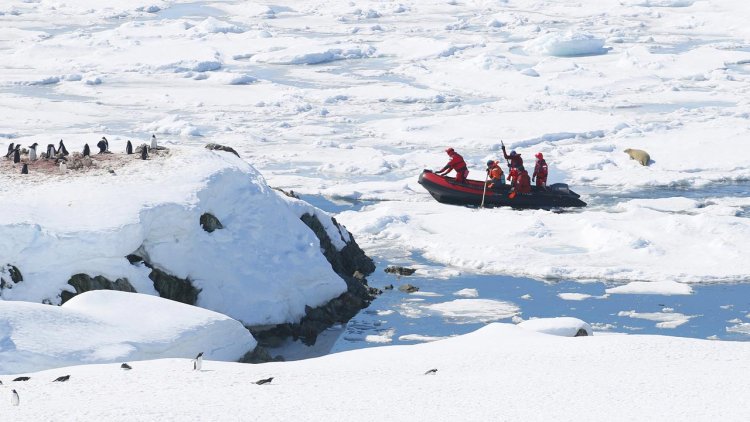
Photo: The scientists return to the station by boat after work on other islands. The icy situation near the station is unfavourable for movement.
Each expedition must include one cook and one doctor. The cook is always assisted by someone from the team, but the doctor has to rely only on his skills.
Evgen Dykyi adds:
“Of course, the station has a well-equipped surgery, but it is not possible to have a real hospital. Accordingly, during the nine winter months, while the station is blocked by ice, the doctor must deal with any situation on his own. We have already had a critical situation when urgent medical care was needed. Then we fully felt the support and solidarity of the polar community.
In 2018, one of the expedition team members had an exacerbation of appendicitis. Our doctor tried to perform the operation in the station, but it turned out that there was a complication – peritonitis. We started looking for help, and we were very lucky. At that time there was an American icebreaker in our area and in two hours I had an answer from the Americans that they were ready to come to our station and pick up the patient. They took him 450 km to the nearest point where the plane could land. A Chilean sea transport plane was already waiting there, it took the patient to the continent. And for all their assistance, they haven’t taken a penny. Fortunately, our scientist has been cured, and he now wants to return to Antarctica again.
By the way, there were also many cases when our doctor treated tourists from cruise liners. They often call at our station and in addition to the tour sometimes have to provide medical assistance to passengers.”
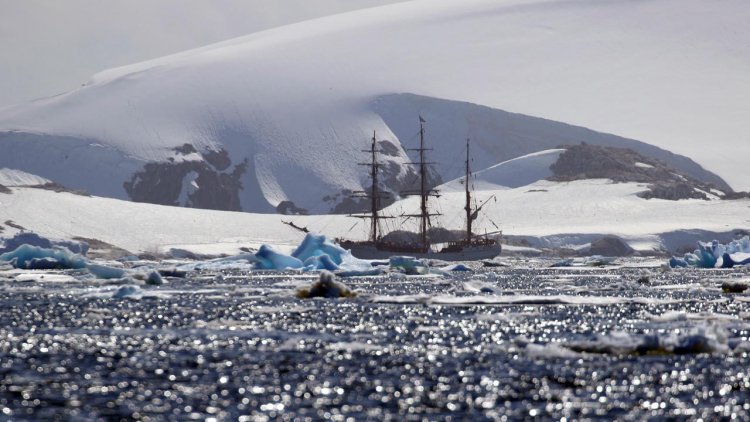
Photo: The cruise barque Europe visits the Akademik Vernadsky station every year, sometimes even several times a season.
The station has become a tourist attraction of Antarctica
In distant Antarctica, the ship’s appearance is always a big event. After all, for the whole expedition team at the station, it means meeting and communicating with new people who are not seen here for 8-9 months in a row. Oksana Savenko says:
“Tourism is a really important part of life at the Akademik Vernadsky station. Visits of tourists help to relax morally and gain new positive emotions. It is also an important mission for us – to represent Ukraine with dignity and to acquaint people from all over the world with our country. Especially since we are often visited by really famous people, scientists, sailors, travellers. We tell them many interesting stories about our research base. Journalists make documentaries about Antarctica and our scientists provide comments and talk about the station and Ukrainian research. Moreover, if small yachts with a limited number of people arrive, we invite guests to chat in the evening in our famous bar.”
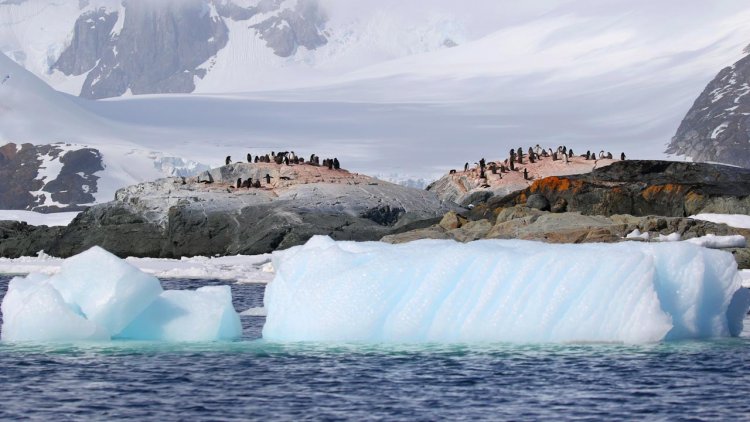
Photo: Adelie penguin colony on the Yalury Islands, near the station.
Oksana admits that some tourists find the Akademik Vernadsky station very modest, as the base is really small. But usually working in such a somewhat spartan environment causes tourists only respect and additional interest. The station already has real friends who have been visiting the Academician Vernadsky station on their yachts for 20 years. They come here absolutely purposefully.
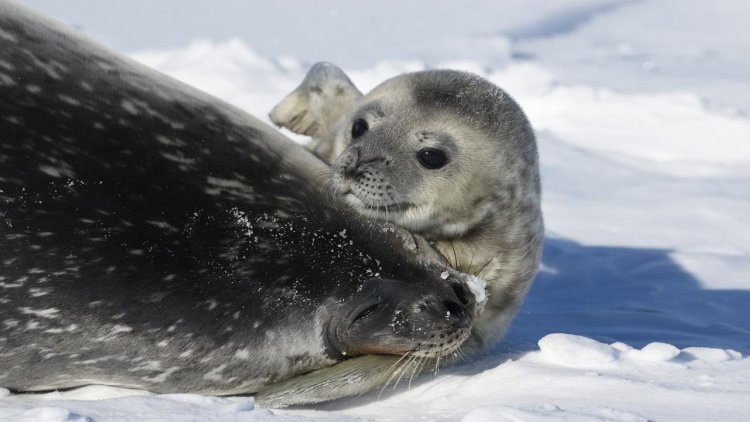
Photo: Weddell seals breed near the station every year.
Oksana Savenko adds:
“Tourists are interested here, they are constantly asking about everything. They ask about life and scientific things. Usually, guests have a good impression of the station. Once a Chinese couple came to us and photographed themselves in wedding dresses at the background of the station. This interest can be understood: when you are sailing on a large liner and around you the same picture – icebergs, whales, seals, penguins – it can be boring. And suddenly you see among the ice the aborigines who have lived here for a long time!”
Unfortunately, in 2021, cruise liners are unlikely to call at the station as often as before. The COVID-19 pandemic has left its mark on the tourism sector. Nevertheless, Ukrainian scientists continue their polar research. The 25th scientific expedition is working at the Antarctic Akademik Vernadsky station now. And the next expedition set off from Kyiv to the station on January 20, 2021. The seasonal detachment should reach Antarctica by mid-February. This means that long-term observations, which have been conducted there for more than 70 years, will continue.
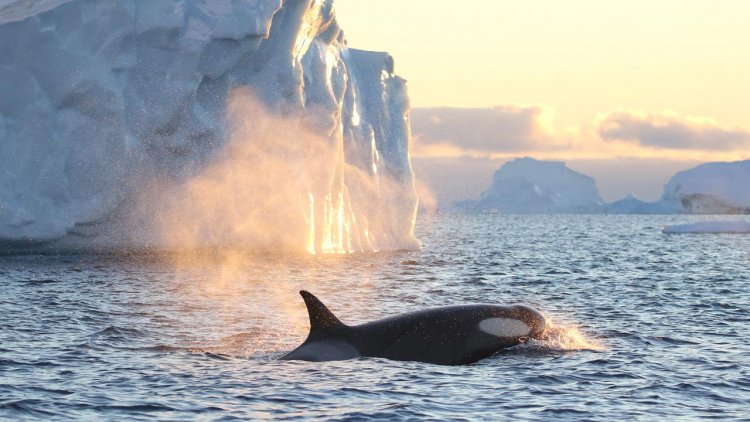
Photo: Meeting with orcas near the station almost in the middle of Antarctic winter.
by Iryna Umanets

